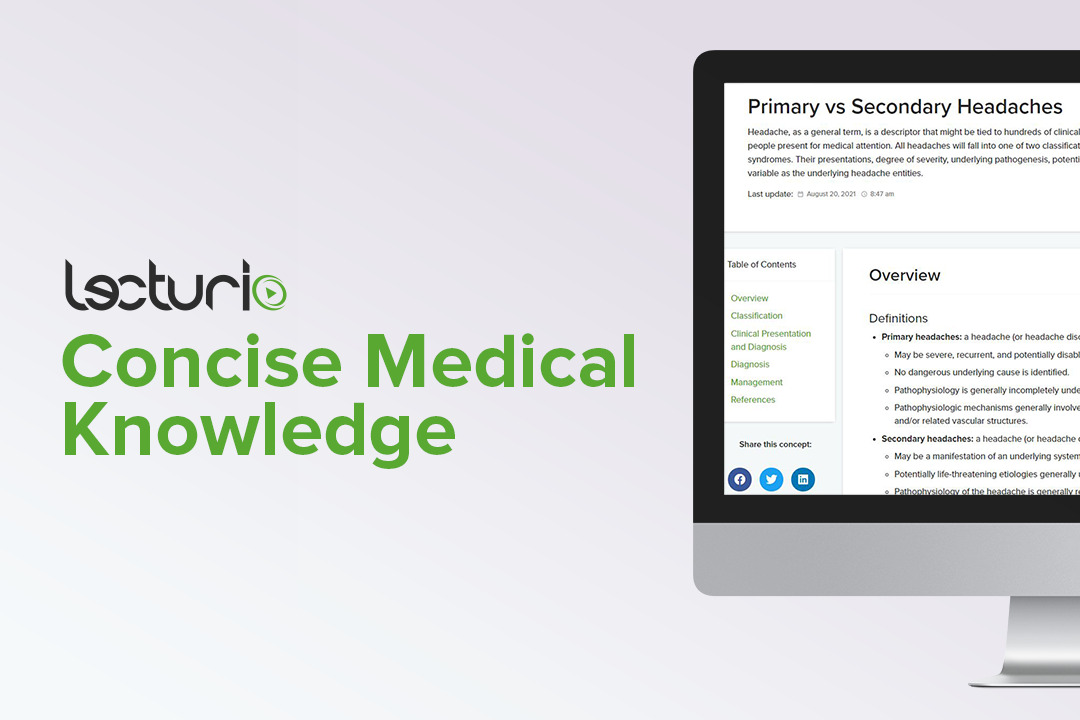Playlist
Show Playlist
Hide Playlist
Hemicrania Continua
-
Slides Headaches Paroxysmal Episodic Headaches.pdf
-
Download Lecture Overview
00:01 And then the last condition that falls within this bucket of trigeminal autonomic cephalalgias is hemicrania continua. 00:09 This was previously not considered a TAC, but is now grouped with the TACs and so we'll consider it in that same group of conditions. 00:17 But it's different. It has some key differences. 00:19 The duration of these headaches is greater than 3 months. 00:22 It is continua, continuous hemisided headache. 00:28 Unilateral pain without side shift. 00:32 So with cluster, we said the the side of head pain is locked during the cluster, but can alternate between the episodes of cluster and here we see that there is no side shift with himecrania continua, it's always on the same side daily continuous head pain without pain free periods. 00:50 And that's really one of the prominent differences between hemicrania continua and all the other 3 TACs is this lack of pain free periods in between episodes of worsening head pain. 01:02 And the pain is typically moderate in severity with exacerbations of severe pain. 01:06 But it's often not quite as bad as the other TACs that we've discussed. 01:11 Patients will often describe and have at least one autonomic finding, conjunctival injection/lacrimation, nasal congestion/rhinorrhea, ptosis/miosis. 01:20 So it does fall in the category of the TACs with autonomic features. 01:24 There is complete response to indomethacin. 01:27 So similar to paroxysmal hemicrania, we see that this is an indomethacin responsive headache, and it must not be attributed to any other disorder. 01:36 So what does it look like? How do patients describe and how do we vizualise hemicrania continua in patients? Well, compared to other TACs, there's more prominent migrainous features and less prominent cranial autonomic features. 01:49 And so that's different than what we've discussed with cluster, paroxysmal hemicrania and SUNCT. 01:55 And this is what the headache looks like. 01:57 So there's really an underlying headache severity that is present at all times. 02:01 Patients never have a headache free interval where things go down to normal where there's really not a severe headache. 02:06 And in between that there are episodes of spiking headaches that are much more severe, again, followed by a period of more chronic and indolent headache that is present at all times. 02:18 To differentiate hemicrania continua from the other TACs, we can consider a number of features, including the migrainous features and the presence of autonomic features. 02:28 Headache attacks are short lasting with something sooner lasting 10 minutes and paroxysmal hemicrania is around 30 minutes and cluster is less than 180 minutes and we typically see headaches that are longer with hemicrania continua. 02:41 The pain in hemicrania continua is continuous. 02:44 That's why it's called hemicrania continua and that's critical in making this diagnosis and differentiating it from the other TACs. 02:52 And the pain in hemicrania continua usually not as severe or excruciatingly severe as that with the other TACs. 03:00 How do we treat hemicrania continua? Well reported cases of indomethacin failure have been described. 03:07 But this is really a indomethacin responsive headache. 03:10 So we treat with indomethacin. 03:12 And it's likely that those with prior failure, it failed to get to an adequate dose of this medication. 03:17 So this is really important for these patients, it can be one of the most effective treatments. 03:22 Variable responsive seeing the insets may respond to topiramate and occipital nerve blocks can be attempted in some cases. 03:32 So, to end, we have a table that describes each of the TACs. 03:36 Cluster, paroxysmal hemicrania, SUNCT and hemicrania continua. 03:41 And this can be an important reference as we look to differentiate each of these prominent autonomic episodic headaches, both in their gender predilection or sex predilection, pain severity, attack duration, which is key that difference in attack duration is key in differentiating these syndromes, the attack frequency, triggers, whether it's episodic or chronic. 04:04 The presence of migraine features which we said is more common in hemicrania continua. 04:09 Whether there's a circadian rhythm component to it, sumatriptan or triptan response and indomethacin responsiveness. 04:15 And indomethacin responsiveness is critical for diagnosing paroxysmal hemicrania and hemicrania continua.
About the Lecture
The lecture Hemicrania Continua by Roy Strowd, MD is from the course Headache.
Included Quiz Questions
Which of the trigeminal autonomic cephalgias is characterized by pain that is more continuous and less severe than the others?
- Hemicrania continua
- Cluster headaches
- Paroxysmal hemicrania
- SUNCT/SUNA headaches
- Migraine headaches
What type of headache has an incidence two times more common in women than men?
- Hemicrania continua
- Cluster headaches
- Episodic paroxysmal hemicrania
- SUNCT/SUNA
- Occipital neuralgia
Customer reviews
5,0 of 5 stars
| 5 Stars |
|
5 |
| 4 Stars |
|
0 |
| 3 Stars |
|
0 |
| 2 Stars |
|
0 |
| 1 Star |
|
0 |




